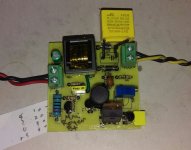OK, the circuit I built is a simplified derivative of the Jim Williams ckt on p2 of that app note I linked. And basically made of all junk bin parts, so component values were not critical and some changed during the build.
 View attachment 5883
View attachment 5883
The topology is "current fed royer" - by adjusting the tail current through the oscillator, the output voltage can be regulated. A three-coil transformer was wound on a tiny unknown core with normal AL=1400, but I gapped it by 2x0.1mm (sticky paper) to result in an AL around 200 and a saturation current of more than 5A. If I had thinner paper, I would have gapped it less!

The transformer is 10T (5Tx2) center tapped primary, 4T aux (base drive), and 200T (100T x 2) secondary. This ratio was chosen to give >200V out when fed from 5-12V, but since I only had a 10k pot on hand my circuit here only has an adjustment range from about 100-180V.
10T primary and 200nH/T^2 gives a 200uH primary, so I set the resonator cap to 6.8n for about 136kHz. It ended up more like 170kHz, which is fine. Probably my trafo taping was weak so my gap was wider, and AL lower than I expected.
Regulation is through TL431 and the NMOS used to set the oscillator current - when the voltage feedback reaches 2.5V, the NMOS gate voltage is reduced and the oscillator current is throttled down. My circuit is currently using 1.6k for 2n2222 base drive to force the beta to around 50-60, and the 270 Ohm pullup for the NMOS was an experiment to lower the TL431 AC gain - it's not necessary to use this small of a value. 1k should be fine. The TL431 is compensated with 1n cathode to FB, and a 200pf feedforward on the top 1M feedback resistor completes the AC response.
By fooling with the secondary turns, you could easily change the output voltage working range to something entirely different. But for slight adjustments, we can just change the feedback resistors. I'd leave the top one at 1M to avoid adjusting the 220p feedforward, but the lower feedback resistors could be anything. The lower feedback resistors are made of two parts: A fixed resistor to set the absolute maximum output voltage to avoid blowing up the rectifier diodes, and a potentiometer to give some output adjustment - it's fine to also use a fixed divider for a fixed output.
I use this supply for playing around with russian subminiature tubes like 6n16b, and it happily delivers a watt or two at 120-150V. Due to the TL431, the regulation is actually quite good.
Attached are the schematics and pdf of the pcb, along with the ltspice schematic I use for experimenting.
EDIT: Oh yeah - one mistake in the eagle schematic - I forgot the 1n compensation on the TL431! That's why it's soldered directly the the TL431 pin, ha ha. I should probably fix that.



